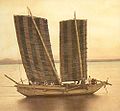Fishing vessel
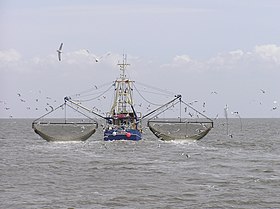

Afishing vesselis aboatorshipused tocatchfishand other valuablenektonicaquatic animals(e.g.shrimps/prawns,krills,coleoids,etc.) in thesea,lakeorriver.Humanshave used different kinds of surface vessels incommercial,artisanalandrecreational fishing.
Prior to the 1950s there was little standardisation of fishing boats. Designs could vary between localities and even differentboatyards.Traditional fishing boats were built ofwood,which is not often used nowadays because of higher maintenance costs and lower durability.Fibreglassis used increasingly in smaller fishing vessels up to 25 metres (100-tonne displacement), whilesteelis usually used on vessels above 25 metres.
It is difficult to estimate the number ofrecreational fishing boats.They range in size from smalldinghies,sailboatsandmotorboatsto largesuperyachtsand charteredcruiseliners.Unlike commercial fishing vessels, recreational fishing vessels are often more for leisurelycruisingother than dedicated just to fishing.
History[edit]
Traditional fishing boats[edit]

Early fishing vessels includedrafts,dugout canoes,and boats constructed from a frame covered withhideortree bark,along the lines of acoracle.[1]The oldest boats found by archaeological excavation are dugout canoes dating back to theNeolithic Periodaround 7,000-9,000 years ago. These canoes were often cut fromconiferous treelogs, using simplestone tools.[1][2]A 7,000-year-old seagoing boat made from reeds and tar has been found in Kuwait.[3]These early vessels had limited capability; they could float and move on water, but were not suitable for use any great distance from the shoreline. They were used mainly forfishingandhunting.
The development of fishing boats took place in parallel with the development of boats for trade and war. Early navigators began to use animal skins or woven fabrics forsails.Affixed to a pole set upright in the boat, these sails gave early boats more range, allowing voyages of exploration.
Around 4000 B.C.,Egyptianswere building long narrow boats powered by many oarsmen. Over the next 1,000 years, they made a series of remarkable advances in boat design. They developed cotton-made sails to help their boats go faster with less work. Then they built boats large enough to cross the oceans. These boats had sails and oarsmen, and were used for travel and trade. By3000 BC,the Egyptians knew how to assembleplanksofwoodinto aship hull.[4]They used wovenstrapsto lashplankstogether,[4]andreedsorgrassstuffed between the planks to seal the seams.[4]An example of their skill is theKhufu ship,a vessel 143 feet (44 m) in length entombed at the foot of theGreat Pyramid of Gizaaround 2,500 BC and found intact in 1954.
At about the same time, theScandinavianswere also building innovative boats. People living nearKongens Lyngbyin Denmark, came up with the idea of segregated hull compartments, which allowed the size of boats to gradually be increased. A crew of some two dozenpaddledthe woodenHjortspring boatacross theBaltic Sealong before the rise of theRoman Empire.Scandinavians continued to develop better ships, incorporatingironand other metal into the design and developingoarsfor propulsion.
By 1000 A.D. theNorsemenwere pre-eminent on the oceans. They were skilled seamen and boat builders, with clinker-built boat designs that varied according to the type of boat. Trading boats, such as theknarrs,were wide to allow large cargo storage. Raiding boats, such as thelongship,were long and narrow and very fast. The vessels they used for fishing were scaled down versions of their cargo boats. TheScandinavianinnovations influenced fishing boat design long after the Viking period came to an end. For example,yolesfrom the OrkneyIsland of Stromawere built in the same way as the Norse boats.
Early modern designs[edit]
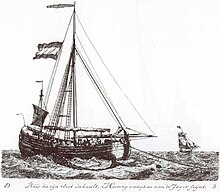
In the 15th century, the Dutch developed a type of seagoingherringdrifterthat became a blueprint for European fishing boats. This was theHerring Buss,used by Dutch herring fishermen until the early 19th centuries. The ship typebusshas a long history. It was known around 1000 AD in Scandinavia as abǘza,a robust variant of the Viking longship. The first herring buss was probably built inHoornaround 1415. The ship was about 20 metres long and displaced between 60 and 100 tons. It was a massive round-bilgedkeelship with a bluffbowandstern,the latter relatively high, and with a gallery. The busses used long driftinggill netsto catch the herring. The nets would be retrieved at night and the crews of eighteen to thirty men[5]would set togibbing,salting and barrelling the catch on the broad deck.
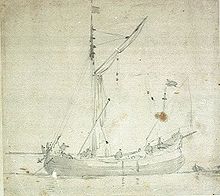
During the 17th century, the British developed thedogger,an early type of sailingtrawlerorlongliner,which commonly operated in theNorth Sea.[6]Doggers were slow but sturdy, capable of fishing in the rough conditions of the North Sea.[7]Like the herring buss, they were wide-beamed and bluff-bowed, but considerably smaller, about 15 metres long, a maximum beam of 4.5 metres, a draught of 1.5 metres, and displacing about 13 tonnes. They could carry a tonne of bait, three tonnes of salt, half a tonne each of food and firewood for the crew, and return with six tonnes of fish.[7]Decked areas forward and aft probably provided accommodation, storage and a cooking area. An anchor would have allowed extended periods fishing in the same spot, in waters up to 18 metres deep. The dogger would also have carried a small open boat for maintaining lines and rowing ashore.[7]
A precursor to thedorytype was the earlyFrenchbateautype, a flat bottom boat with straight sides used as early as 1671 on theSaint Lawrence River.[8]The common coastal boat of the time was thewherryand the merging of the wherry design with the simplified flat bottom of the bateau resulted in the birth of the dory. England, France, Italy, and Belgium have small boats from medieval periods that could reasonably be construed as predecessors of the Dory.[9]
Doriesappeared inNew Englandfishing towns sometime after the early 18th century.[10]They were small, shallow-draftboats,usually about five to seven metres (15 to 22 feet) long. Lightweight and versatile, with high sides, a flat bottom and sharp bows, they were easy and cheap to build. TheBanks doriesappeared in the 1830s. They were designed to be carried onmother shipsand used for fishingcodat theGrand Banks.[10]Adapted almost directly from the low freeboard, French river bateaus, with their straight sides and removable thwarts, bank dories could be nested inside each other and stored on the decks of fishing schooners, such as theGazela Primeiro,for their trip to the Grand Banks fishing grounds.
Modern fishing trawler[edit]


The Portuguesemulettaand the Britishdoggerwere early types of sailing trawler in use before the 17th century and onward, but the modern fishing trawler was developed in the 19th century.
By the early 19th century, the fishermen atBrixham,needed to expand their fishing area further than ever before due to the ongoing depletion of stocks that was occurring in theoverfishedwaters ofSouth Devon.TheBrixham trawlerthat evolved there was of a sleek build and had a tallgaff rig,which gave the vessel sufficient speed to make long-distance trips out to the fishing grounds in the ocean. They were also sufficiently robust to be able to tow large trawls in deep water. The great trawling fleet that built up at Brixham, earned the village the title of 'Mother of Deep-Sea Fisheries'.
This revolutionary design made large scale trawling in the ocean possible for the first time, resulting in a massive migration of fishermen from the ports in the South of England, to villages further north, such asScarborough,Hull,Grimsby,HarwichandYarmouth,that were points of access to the large fishing grounds in theAtlantic Ocean.
The small village ofGrimsbygrew to become the largest fishing port in the world by the mid 19th century.[11][12]With the tremendous expansion in the fishing industry, theGrimsby Dock Companywas formed in 1846. The dock covered 25 acres (10 ha) and was formally opened byQueen Victoriain 1854 as the first modern fishing port. The facilities incorporated many innovations of the time - the dock gates and cranes were operated byhydraulic power,and the 300-foot (91 m)Grimsby Dock Towerwas built to provide a head of water with sufficient pressure byWilliam Armstrong.[13]
The elegantBrixham trawlerspread across the world, influencing fishing fleets everywhere. Their distinctive sails inspired the songRed Sails in the Sunset,written aboard a Brixham sailing trawler called theTorbayLass.[14][15]By the end of the 19th century, there were over 3,000 fishing trawlers in commission in Britain, with almost 1,000 at Grimsby. These trawlers were sold to fishermen around Europe, including from theNetherlandsandScandinavia.Twelve trawlers went on to form the nucleus of the German fishing fleet.[16]
Although fishing vessel designed increasingly began to converge around the world, local conditions still often led the development of different types of fishing boats. TheLancashire nobbywas used down the north west coast of England as a shrimp trawler from 1840 until World War II. TheManx nobbywas used around theIsle of Manas a herring drifter. Thefifiewas also used as a herring drifter along the east coast of Scotland from the 1850s until well into the 20th century.
Advent of steam power[edit]
The earliest steam powered fishing boats first appeared in the 1870s and used thetrawlsystem of fishing as well as lines and drift nets. These were large boats, usually 80–90 feet (24–27 m) in length with a beam of around 20 feet (6.1 m). They weighed 40-50 tons and travelled at 9–11 knots (17–20 km/h; 10–13 mph).
The earliest purpose built fishing vessels were designed and made by David Allan inLeithin March 1875, when he converted a drifter to steam power. In 1877, he built the firstscrew propelledsteam trawlerin the world. This vessel wasPioneer LH854.She was of wooden construction with two masts and carried a gaff rigged main and mizen using booms, and a single foresail.Pioneeris mentioned inThe Shetland Timesof 4 May 1877. In 1878 he completedForwardandOnward,steam-powered trawlers for sale. Allan built a total of ten boats atLeithbetween 1877 and 1881. Twenty-one boats were completed atGranton,his last vessel beingDegravein 1886. Most of these were sold to foreign owners in France,Belgium,Spainand theWest Indies.[17]
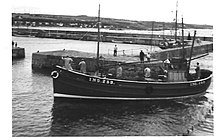
The firststeam boatswere made of wood, butsteelhullswere soon introduced and were divided intowatertightcompartments. They were well designed for the crew with a large building that contained thewheelhouseand thedeckhouse.The boats built in the 20th century only had amizzensail,which was used to help steady the boat when its nets were out. The main function of the mast was now as acranefor lifting the catch ashore. It also had a steamcapstanon theforedecknear the mast for haulingnets.The boats had narrow, highfunnelsso that the steam and thick coal smoke was released high above the deck and away from the fishermen. These funnels were nicknamedwoodbinesbecause they looked like the popular brand of cigarette. These boats had a crew of twelve made up of askipper,driver, fireman (to look after the boiler) and nine deck hands.[17]
Steam fishing boats had many advantages. They were usually about 20 ft longer (6.1 m) than the sailing vessels so they could carry more nets and catch more fish. This was important, as the market was growing quickly at the beginning of the 20th century. They could travel faster and further and with greater freedom fromweather,wind andtide.Because less time was spent travelling to and from the fishing grounds, more time could be spent fishing. The steam boats also gained the highest prices for their fish, as they could return quickly to harbour with their fresh catch. The main disadvantage of the steam boats, though, was their high operating costs. Their engines were mechanically inefficient and took up much space, while fuel and fitting out costs were very high. Before theFirst World War,building costs were between 3,000 and £4,000, at least three times the cost of the sail boats. To cover these high costs, they needed to fish for longer seasons. The higher expenses meant that more steam drifters were company-owned or jointly owned. As the herring fishing industry declined, steam boats became too expensive.[17] Steam trawlers were introduced atGrimsbyandHullin the 1880s. In 1890 it was estimated that there were 20,000 men on the North Sea. The steam drifter was not used in the herring fishery until 1897. The last sailing fishing trawler was built in 1925 in Grimsby.
Further development[edit]

Trawler designs adapted as the way they were powered changed from sail to coal-fired steam byWorld War Itodieselandturbinesby the end ofWorld War II.
The first trawlers fished over the side, rather than over thestern.In 1947, the companyChristian Salvesen,based inLeith,Scotland, refitted a surplusAlgerine-class minesweeper(HMSFelicity) with refrigeration equipment and a factory ship stern ramp, to produce the first combined freezer/stern trawler in 1947.[18]
The first purpose-built stern trawler wasFairtrybuilt in 1953 atAberdeen.The ship was much larger than any other trawlers then in operation and inaugurated the era of the 'super trawler'. As the ship pulled its nets over the stern, it could lift out a much greater haul of up to 60 tons.Lord Nelsonfollowed in 1961, installed with vertical plate freezers that had been researched and built at theTorry Research Station.These ships served as a basis for the expansion of 'super trawlers' around the world in the following decades.[18]
In recent decades, commercial fishing vessels have been increasingly equipped with electronic aids, such asradio navigation aidsandfish finders.During theCold War,some countries fitted fishing trawlers with additional electronic gear so they could be used asspy shipsto monitor the activities of other countries.
Global trends[edit]
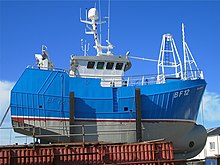

About 1.3 million of these are decked vessels with enclosed areas. Nearly all of these decked vessels are mechanised, and 40,000 of them are over 100 tons. At the other extreme, two-thirds (1.8 million) of theundeckedboats are traditional craft of various types, powered only by sail and oars.[19]These boats are used byartisan fishers.
TheCape Town Agreementis an internationalInternational Maritime Organizationlegal instrument established in 2012, that sets out minimum safety requirements forfishing vesselsof 24 metres in length and over or equivalent in gross tons.[20]
Commercial vessels[edit]

The200-mile fishing limithas changed fishing patterns and, in recent times, fishing boats are becoming more specialised and standardised. In the United States and Canada more use is made of largefactory trawlers,while the huge blue water fleets operated by Japan and theSoviet-bloccountries have contracted. In western Europe, fishing vessel design is focused on compact boats with high catching power.
Commercial fishingis a high risk industry, and countries are introducing regulations governing the construction and operation of fishing vessels. TheInternational Maritime Organization,convened in 1959 by theUnited Nations,is responsible for devising measures aimed at the prevention of accidents, including standards for ship design, construction, equipment, operation and manning.
According to theFAO,in 2004 the world's fishing fleet consisted of 4 million vessels. Of these, 1.3 million were decked vessels with enclosed areas. The rest were open vessels, of which two-thirds were traditional craft propelled by sails and oars.[19]By contrast, nearly all decked vessels were mechanized. Of the decked vessels, 86 percent are found in Asia, 7.8 percent in Europe, 3.8 percent in North and Central America, 1.3 percent in Africa, 0.6 percent in South America and 0.4 percent in Oceania.[19]Most commercial fishing boats are small, usually less than 30 metres (98 ft) but up to 100 metres (330 ft) for a largepurse seinerorfactory ship.
Commercial fishing vessels can be classified by architecture, the type of fish they catch, the fishing method used, or geographical origin. The following classification follows theFAO,[21]who classify commercial fishing vessels by the gear they use.
Fishing gear[edit]
-
Drum winches mounted at the stern of an Irish trawler
Trawlers[edit]
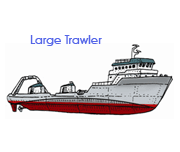
Atrawleris a fishing vessel designed to usetrawlnets in order to catch large volumes of fish.[22]
- Outrigger trawlers– use outriggers to tow the trawl. These are commonly used to catchshrimp.One or two otter trawls can be towed from each side. Beam trawlers, employed in the North sea for catching flatfish, are another form of outrigger trawler. Medium-sized and high powered vessels, these tow a beam trawl on each side at speeds up to 8 knots.[23]
- Beam trawlers– use sturdy outrigger booms for towing a beam trawl, one warp on each side. Double-rig beam trawlers can tow a separate trawl on each side of the trawler. Beam trawling is used in theflatfishandshrimpfisheries in theNorth Sea.They are medium-sized and high powered vessels, towing gear at speeds up to 8 knots. To avoid the boat capsizing if the trawl snags on the sea floor, winch brakes can be installed, along with safety release systems in the boom stays. The engine power of bottom trawlers is also restricted to 2000 HP (1472 KW) for further safety.[24]
- Otter trawlers– deploy one or more parallel trawls kept apart horizontally usingotter boards.These trawls can be towed in midwater or along the bottom.[25]
- Pair trawlers– are trawlers whichoperate togethertowing a single trawl. They keep the trawl open horizontally by keeping their distance when towing. Otter boards are not used. Pair trawlers operate both midwater and bottom trawls.[26]
- Side trawlers– have the trawl set over the side with the trawl warps passing through blocks which hang from two gallows, one forward and one aft. Until the late sixties, side trawlers were the most familiar vessel in the North Atlantic deep sea fisheries. They evolved over a longer period than other trawler types, but are now being replaced by stern trawlers.[27]
- Stern trawlers– have trawls which are deployed and retrieved from the stern. Larger stern trawlers often have a ramp, thoughpelagicand small stern trawlers are often designed without a ramp. Stern trawlers are designed to operate in most weather conditions. They can work alone when midwater or bottom trawling, or two can work together as pair trawlers.[28]
- Freezer trawlers– The majority of trawlers operating on high sea waters are freezer trawlers. They have facilities for preserving fish by freezing, allowing them to stay at sea for extended periods of time. They are medium to large size trawlers, with the same general arrangement as stern or side trawlers.[29]
- Wet fish trawlers– are trawlers where the fish is kept in the hold in a fresh/wet condition. They must operate in areas not far distant from their landing place, and the fishing time of such vessels is limited.[30]
Seiners[edit]

Seinersusesurroundingandseine nets.This is a large group ranging from open boats as small as 10 metres (33 ft) in length to ocean-going vessels. There are also specialised gears that can targetdemersalspecies.[31][32]
- Purse seiners are very effective at targetingaggregatingpelagicspecies near the surface. The seiner circles the shoal with a deep curtain of netting, possibly usingbow thrustersfor better manoeuvrability. Then the bottom of the net is pursed (closed) underneath the fish shoal by hauling a wire running from the vessel through rings along the bottom of the net and then back to the vessel. The most important part of the fishing operation is searching for the fish shoals and assessing their size and direction of movement. Sophisticated electronics, such as echosounders, sonar, and track plotters, may be used are used to search for and trackschools;assessing their size and movement and keeping in touch with the school while it is surrounded with the seine net. Crows nests may be built on the masts for further visual support. Large vessels can have observation towers and helicopter landing decks. Helicopters and spotter planes are used for detecting fish schools. The main types of purse seiners are the American seiners, the European seiners and the Drum seiners.[33]
- American seiners have their bridge and accommodation placed forward with the working deck aft. American seiners are most common on both coasts of North America and in other areas of Oceania. The net is stowed at the stern and is set over the stern. Thepower blockis usually attached to a boom from a mast located behind the superstructure. American seiners use Triplerollers.[34]A purse line winch is located amidships near the hauling station, near the side where the rings are taken on board.[32]
- European seiners have their bridge and accommodation located more to the after part of the vessel with the working deck amidships. European seiners are most common in waters fished by European nations. The net is stowed in a net bin at the stern, and is set over the stern from this position. The pursing winch is normally positioned at the forward part of the working deck.[35]
- Drum seiners have the same layout as American seiners except a drum is mounted on the stern and used instead of the power block. They are mainly used in Canada and USA.[36]
- Tuna purse seiners are large purse seiners, normally over 45 metres, equipped to handle large and heavy purse seines fortuna.They have the same general arrangement as the American seiner, with the bridge and accommodation placed forward. A crows nest or tuna tower is positioned at the top of the mast, outfitted with the control and manoeuvre devices. A very heavy boom which carries the power block is fitted at the mast. They often carry a helicopter to search for tuna schools. On the deck are three drum purse seine winches and a power block, with other specific winches to handle the heavy boom and net. They are usually equipped with a skiff.[37]
- Seine netters - the basic types of seine netters are the anchor seiners and Scottish seiner in northern Europe and the Asian seiners in Asia.[38]
- Anchor seiners have the wheelhouse and accommodation aft and the working deck amidships, thus resembling side trawlers. The seine net is stored and shot from the stern, and they may carry a power block. Anchor seiners have the coiler and winch mounted transversally amidships.[38]
- Scottish seiners are basically configured the same as anchor seiners. The only difference is that, whereas the anchor seiner has the coiler and winch mounted transversally amidships, the Scottish seiner has them mounted transversally in the forward part of the vessel.[38]
- Asian seiners – In Asia, the seine netter usually has the wheelhouse forward and the working deck aft, in the manner of a stern trawler. However, in regions where the fishing effort is a labour-intensive, low-technology approach, they are often undecked and may be powered by outboards motors, or even by sail.[38]
-
Purse seiner
-
Large purse seiner
-
Spanish tuna purse seiner,Albatun Dos,nearVictoria, Seychelles
Line vessels[edit]
Line vessels –
- Longliners– use one or more long heavyfishing lineswith a series of hundreds or even thousands ofbaitedhookshanging from the main line by means of branch lines called "snoods". Hand operated longlining can be operated from boats of any size. The number of hooks and lines handled depends on the size of vessel, the number of crew, and the level of mechanisation. Large purpose built longliners can be designed for single species fisheries such astuna.On such larger vessels the bridge is usually placed aft, and the gear is hauled from the bow or from the side with mechanical or hydraulic line haulers. The lines are set over the stern. Automatic or semi-automatic systems are used to bait hooks and shoot and haul lines. These systems include rail rollers, line haulers, hook separators, dehookers and hook cleaners, and storage racks or drums. To avoidincidental catchesof seabirds, an outboard setting funnel is used to guide the line from the setting position on the stern down to a depth of one or two metres. Small scale longliners handle the gear by hand. The line is stored into baskets or tubs, perhaps using a hand cranked line drum.[39]
- Bottom longliners –[40]
- Midwater longliners – are usually medium-sized vessels which operate worldwide, purpose built to catch largepelagics.The line hauler is usually forward starboard, where the fish are hauled through a gate in the rail. The lines are set from the stern where a baiting table and chute are located. These boats need adequate speed to reach distant fishing grounds, enough endurance for continued fishing, adequate freezing storage, suitable mechanisms for shooting and hauling longlines quickly, and proper storage for fishing gears and accessories.[41]
- Freezer longliners – are outfitted with freezing equipment. The holds are insulated and refrigerated. Freezer longliners are medium to large with the same general characteristics of other longliners. Most longliners operating on thehigh seasare freezer longliners.[42]
- Factory longliners– are generally equipped with processing plant, including mechanical gutting and filleting equipment accompanied by freezing facilities, as well as fish oil, fish meal and sometimes canning plants. These vessels have a large buffer capacity. Thus, caught fish can be stored in refrigerated sea water tanks and peaks in the catch can also be used. Freezer longliners are large ships, working thehigh seaswith the same general characteristics of other large longliners.[43]
- Wet-fish longliners – keep the caught fish in the hold in the fresh/wet condition. The fish is stored in boxes and covered with ice, or stored with ice in the fish hold. The fishing time of such vessels is limited, so they operate close to the landing place.[44]
| External image | |
|---|---|
- Pole and line vessels – are used mainly to catchtunaandskipjack.The fishers stand at the railing or on special platforms and fish withpolesandlines.The lines havehookswhich arebaited,preferably withlive bait.Caught tuna are swung on board, by two to three fishermen if the tuna is big, or with an automated swinging mechanism. The tuna usually release themselves from the barbless hook when they hit the deck. Tanks with live bait are placed round the decks, and water spray systems are used to attract the fish. The vessels are 15 to 45 metreso/a.On smaller vessels fishers fish from the main deck right around the boat. With larger vessels, there are two different deck styles: the American style and the Japanese style.[45]
- American style – fishers stand on platforms arranged over the side abaft amidships and around the stern. The vessel moves ahead during fishing operation.[45]"Drawing".FAO.
- Japanese style – fishers stand at the rail in the forepart of the vessel. The vessel drifts during fishing operations.[45]"Drawing".FAO.
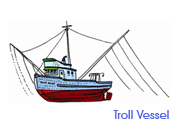
- Trollers– catch fish by towing astern one of more trolling lines. A trolling line is afishing linewithnaturalorartificial baitedhookstrailed by a vessel near the surface or at a certain depth. Several lines can be towed at the same time using outriggers to keep the lines apart. The lines can be hauled in manually or by small winches. A length of rubber is often included in each line as a shock absorber. The trolling line is towed at a speed depending on the target species, from 2.3 knots up to at least 7 knots. Trollers range from small open boats to large refrigerated vessels 30 metres long. In many tropicalartisanal fisheries,trolling is done with sailing canoes with outriggers for stability. With properly designed vessels, trolling is an economical and efficient way of catchingtuna,mackereland otherpelagicfish swimming close to the surface. Purpose-built trollers are usually equipped with two or four trolling booms raised and lowered by topping lifts, held in position by adjustable stays. Electrically powered or hydraulic reels can be used to haul in the lines.[46]
- Jiggers – there are two types of jiggers: specialisedsquidjiggers which work mostly in the southern hemisphere and smaller vessels using jigging techniques in the northern hemisphere mainly for catchingcod.[47]
- Squid jiggers – have single or double drum jigger winches lined along the rails around the vessel. Strong lamps, up to 5000 W each, are used to attract the squid. These are arranged 50–60 centimetres apart, either as one row in the centre of the vessel, or two rows, one on each side. As the squid are caught they are transferred by chutes to the processing plant of the vessel. The jigging motion can be produced mechanically by the shape of the drum or electronically by adjustment to the winch motor. Squid jiggers are often used during the day as midwater trawlers and during the night as jiggers.[47]
- Cod jiggers – use single jigger machines and do not use lights to attract the fish. The fish are attracted by the jigging motion and artificial bait.[47]
Other vessels[edit]
- Dredgers– use a dredge for collectingmolluscsfrom the seafloor. There are three types of dredges: (a) The dredge can be dragged along the seabed, scooping the shellfish from the ground. These dredges are towed in a manner similar to beam trawlers, and large dredgers can work three or more dredges on each side. (b) Heavy mechanical dredging units are operated by special gallows from the bow of the vessel. (c) The dredger employs a hydraulic dredge which uses a powerful water pump to operates water jets which flush the molluscs from the bottom. Dredgers don't have a typical deck arrangement, the bridge and accommodation can be aft or forward. Derricks and winches may be installed for lowering and lifting the dredge. Echosounders are used for determining depths.[48]
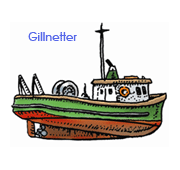
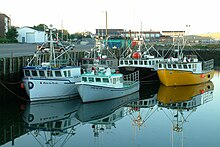


- Gillnetters – On inland waters and inshore,gillnetscan be operated from open boats and canoes. In coastal waters, they are operated by small decked vessels which can have their wheelhouse either aft or forward. In coastal waters, gillnetting is often used as a second fishing method by trawlers or beam trawlers, depending on fishing seasons and targeted species. For offshore fishing, or fishing on thehigh seas,medium-sized vessels using drifting gillnets are calleddrifters,and the bridge is usually located aft. The nets are set and hauled by hand on small open boats. Larger boats use hydraulic or occasionally mechanical net haulers, or net drums. These vessels can be equipped with an echosounder, although locating fish is more a matter of the fishermen's personal knowledge of the fishing grounds rather than depending on special detection equipment.[49]
- Set netters – also operate gillnets. However, during fishing operations the vessel is not attached to the nets. The size of the vessels varies from open boats to large specialised drifters operating on thehigh seas.The wheelhouse is usually located aft, and the front deck is used for handling gear. Normally the nets are set at the stern by steaming ahead. Hauling is done over the side at the forepart of the deck, usually using hydraulic driven net haulers. Wet fish is packed in containers chilled with ice. Larger vessels might freeze the catch.[50]
- Lift netters – are equipped to operate lift nets, which are held from the vessel's side and raised and lowered by means of outriggers. Lift netters range from open boats about 10 metres long to larger vessels with open ocean capability. Decked vessels usually have the bridge amidships. Larger vessels are often equipped with winches and derricks for handling the lifting lines, as well as outriggers and light booms. They can be fitted with powerful lights to attract and aggregate the fish to the surface. Open boats are usually unmechanized or use hand-operated winches. Electronic equipment, such asfishfinders,sonarandecho soundersare used extensively on larger boats.[51]
- Trap setters– are used to setpotsortrapsfor catching fish, crabs, lobsters, crayfish and other similar species. Trap setters range in size from open boats operating inshore to larger decked vessels, 20 to 50 metres long, operating out to the edge of thecontinental shelf.Small decked trap setters have the wheelhouse either forward or aft with the fish hold amidships. They use hydraulic or mechanical pot haulers. Larger vessels have the wheelhouse forward, and are equipped with derricks, davits or cranes for hauling pots aboard. Locating fish is often more a matter of the fishermen's knowledge of the fishing grounds rather than the use of special detection equipment. Decked vessels are usually equipped with an echosounder, and large vessels may also have a Loran or GPS.[52]
- Handliners– are normally undecked vessels used for handlining (fishing with alineandhook). Handliners include canoes and other small or medium-sized vessels. Traditional handliners are less than 12 metreso/a,and do not have special gear handling, there is no winch or gurdy. Locating fish is left to the fishermen's personal knowledge of fishing grounds rather than the use of special electronic equipment. Non traditional handliners can set and haul using electrical or hydraulic powered reels. These mechanised reels are normally fastened to thegunwaleor set onstanchionsclose to or overhanging the gunwale. They operate all over the world, some in shallow waters, some fishing up to 300 metres deep. No typical deck arrangement exists for handliners.[53]
- Multipurpose vessels – are vessels which are designed so they can deploy more than one type of fishing gear without major modifications to the vessels. The fish detection equipment present on board also changes according to which fishing gear is being used.[54]
- Trawler/Purse seiners – are designed so the deck arrangement and equipment, including a suitable combination winch, can be used for both methods. Rollers, blocks, trawl gallows and purse davits need to be arranged so they control the lead of warps and pursing lines in such a way as to reduce the time needed to convert from one type to the other. Typical fish detection equipment includes a sonar and an echosounder. These vessels are usually designed as trawlers, since the power requirement for trawling is higher.[55]
- Research vessels– afisheries researchvessel (FRV) requires platforms which are capable of towing different types offishing nets,collectingplanktonor water samples from a range of depths, and carryingacousticfish-finding equipment. Fisheries research vessels are often designed and built along the same lines as a large fishing vessel, but with space given over tolaboratoriesand equipment storage, as opposed to storage of the catch. An example of a fisheries research vessel isFRVScotia.
Artisan vessels[edit]
Artisan fishingis small-scalecommercialorsubsistencefishing, particularly practices involving coastal or island ethnic groups using traditionalfishing techniquesand traditional boats. This may also include heritage groups involved in customary fishing practices.
According to theFAO,at the end of 2004, the world fishing fleet consisted of about 4 million vessels, of which 2.7 million were undecked (open) boats. While nearly all decked vessels were mechanized, only one-third of the undecked fishing boats were powered, usually with outboard engines. The remaining 1.8 million boats were traditional craft of various types, operated by sail and oars.[19]
These figures for small fishing vessels are probably under reported. TheFAOcompiles these figures largely from national registers. These records often omit smaller boats where registration is not required or where fishing licences are granted by provincial or municipal authorities.[19]
-
Fisherman landing his catch in theSeychelles.
-
Indian split-log fishing canoe
-
Fishing boats in Gambia.
-
Traditional Vietnamese fishing boat
-
Fishing junk, 1871
Artisan fishing boats are usually smalltraditional fishing boats,appropriately designed for use on their local inland waters or coasts. Many localities around the world have developed their own traditional types of fishing boats, adapted to use local materials suitable for boat building and to the specific requirements of thefisheriesand sea conditions in their area. Artisan boats are often open (undecked). Many have sails, but they do not usually use much, or any mechanised or electronic gear. Large numbers of artisan fishing boats are still in use, particularly in developing countries with long productive marine coastlines. For example,Indonesiahas reported about 700,000 fishing boats, 25 percent of which aredugout canoes,and half of which are without motors.[56]ThePhilippineshave reported a similar number of small fishing boats. Many of the boats in this area are double-outrigger craft, consisting of a narrow main hull with two attached outriggers, commonly known asjukungin Indonesia andbancain the Philippines.[57]
-
A smallPhilippinebasniganwith the characteristic poles used for anchoring nets and holding gas-powered lamps for attracting fish
-
Indianclinkerfishing boats
-
Traditional Philippine fishingoutrigger canoes(bangka)
Recreational vessels[edit]

Recreational fishing is done forleisureorsport,and not for profit or survival. Just about anything that will stay afloat can be called a recreational fishing boat, so long as afishermanperiodically climbs aboard with the intent to catch fish. Usually some form offishing tackleis brought on board, such ashooksandlines,rodsandreels,sinkersornets,and occasionally high-tech devices such asfishfindersanddiving drones.Fish are caught for recreational purposes from boats that range fromdugout canoes,kayaks,rafts,pontoon boatsand smalldinghiestorunabouts,cabin cruisersandyachtsto large, high-tech and luxuriousbig game boatssometimes fitted withoutriggers.[58]Larger boats, purpose-built with recreational fishing in mind, usually have large, opencockpitsat thestern,designed for convenient fishing.
Big game fishingstarted as a sport after the invention of the motorized boat.Charles Frederick Holder,amarine biologistand early conservationist, is credited with founding the sport in 1898.[59]Purpose-built game fishing boats appeared shortly after. An example is theCrete,in use at Catalina Island,California,in 1915, and shipped toHawaiithe following year. According to a newspaper report at that time, theCretehad "a deep cockpit, a chair fitted for landing big fish and leather pockets for placing the pole."[60]
It is difficult to estimate how many recreational fishing boats there are, although the number is high. The term is fluid, since most recreational boats are also used for fishing from time to time. Unlike most commercial fishing vessels, recreational fishing boats are often not dedicated just to fishing, but also otherwater sportssuch aswater skiing,parasailingandunderwater diving.
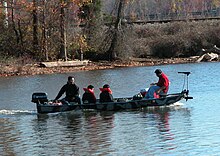
- Fishing kayakshave gained popularity in recent years. Thekayakhas long been a means of accessing fishing grounds.
- Pontoon boatshave also become popular in recent years. These boats allow one or two fishermen to get into small rivers or lakes that would have difficulty accommodating larger boats. Typically 8–12 ft in length, these inflatable craft can be assembled quickly and easily. Some feature rigid frames derived from thewhite water raftingindustry.
- Bass boatsare small aluminium or fibreglass motorboats used in freshwater lakes and rivers in theUnited States.for fishingbassand otherpanfish.They have a flat front deck, swivel chairs for the anglers, storage bins for fishing tackle, and alive wellwith recirculating water to keep caught fish alive. They are usually fitted with anoutboard motorand a slowertrolling motor,as wellfishfinderandGPS navigation.
- Charter boats are often privately operated, purpose-built fishing boats, and host guided fishing trips for paying clients. Their size can range widely depending on the type of trips run and the geographical location.
- Freshwater fishing boats account for approximately one third of all registered boats in the USA. Most other types of boats end up being used for fishing on occasion.
- Saltwater fishing boats vary widely in size and can be specialized for certain species of fish. Flounder boats, for example, have flat bottoms for a shallow draft and are used in protected, shallow waters. Sport fishing boats range from 25 to 80 feet or more, and can be powered by large outboard engines or inboard diesels. Boats used for fishing in cold climates may have space dedicated to acuddy cabinor enclosed wheelhouse, while boats in warmer climates are more likely to be open.
-
Fly fishingfrom adinghy
-
Small sport fishing boat
See also[edit]
- Factory ship
- Maritime history of the United Kingdom
- Shetland bus boats
- Traditional fishing boat
- Western Flyer(boat)
Notes[edit]
- ^abMcGrail 2001, page 431
- ^"Oldest Boat Unearthed".China.org.cn. Archived fromthe originalon 2009-01-02.Retrieved2008-05-05.
- ^Lawler, Andrew (June 7, 2002)."Report of Oldest Boat Hints at Early Trade Routes".Science.296(5574).AAAS:1791–1792.doi:10.1126/science.296.5574.1791.PMID12052936.S2CID36178755.Retrieved2008-05-05.
- ^abc Ward, Cheryl (May–June 2001)."World's Oldest Planked Boats".Archaeology.54(3).
- ^De Vries & Woude (1977), pages 244–245
- ^Oxford Companion to Ships and the Sea, p. 256
- ^abcFagan 2008
- ^Gardner 1987, page 18
- ^Gardner 1987, page 15
- ^abChapelle, page 85
- ^Grimsby heyday of the 'three-day millionaire'BBC,15 November 2012
- ^"A brief history of Grimsby".localhistories.org. 14 March 2021.
- ^"Great Grimsby".UK Genealogy Archives.
- ^"History of a Brixham trawler".JKappeal.org. 2 March 2009. Archived fromthe originalon 2 December 2010.Retrieved13 September2010.
- ^"Pilgrim's restoration under full sail".BBC.Retrieved2 March2009.
- ^Sailing trawlers.10 January 2014.
- ^abc"The Steam Trawler".
- ^ab"HISTORY".Archived fromthe originalon 2013-08-21.Retrieved2015-07-05.
- ^abcdeFAO 2007
- ^"2012 Cape Town Agreement to enhance fishing safety".International Maritime Organization.Retrieved1 November2022.
- ^"Technology Fact Sheets: Fishing Vessel type".FAO.
- ^"Fishing Vessel type: Trawlers".FAO.
- ^"Fishing Vessel type: Outrigger trawlers".FAO."Drawing".FAO. Archived fromthe originalon 2015-09-24.Retrieved2009-01-31.
- ^"Fishing Vessel type: Beam trawlers".FAO."Drawing".FAO. Archived fromthe originalon 2015-09-24.Retrieved2009-01-31.
- ^"Fishing Vessel type: Otter trawlers".FAO.
- ^"Fishing Vessel type: Pair trawlers".FAO.
- ^"Fishing Vessel type: Side trawlers".FAO."Drawing".FAO. Archived fromthe originalon 2012-10-21.Retrieved2009-01-31.
- ^"Fishing Vessel type: Stern trawlers".FAO."Drawing".FAO. Archived fromthe originalon 2015-09-24.Retrieved2009-01-31.
- ^"Fishing Vessel type: Freezer trawlers".FAO."Drawing".FAO. Archived fromthe originalon 2016-03-03.Retrieved2009-01-31.
- ^"Fishing Vessel type: Wet-fish trawlers".FAO."Drawing".FAO. Archived fromthe originalon 2012-10-21.Retrieved2009-01-31.
- ^"Fishing Vessel type: Seiners".FAO.
- ^ab"Fishing Vessel type: American seiners".FAO."Drawing".FAO. Archived fromthe originalon 2015-09-24.Retrieved2009-01-31.
- ^"Fishing Vessel type: Purse seiner".FAO.
- ^"Fishery equipment: Tripleroller".FAO.
- ^"Fishing Vessel type: European seiners".FAO."Drawing".FAO. Archived fromthe originalon 2015-09-24.Retrieved2009-01-31.
- ^"Fishing Vessel type: Drum seiners".FAO."Drawing".FAO. Archived fromthe originalon 2015-09-24.Retrieved2009-01-31.
- ^"Fishing Vessel type: Tuna Purse seiners".FAO."Drawing".FAO. Archived fromthe originalon 2015-09-24.Retrieved2009-01-31.
- ^abcd"Fishing Vessel type: [Seine netters".FAO."Drawing".FAO. Archived fromthe originalon 2015-09-24.Retrieved2009-01-31.
- ^"Fishing Vessel type: Longliners".FAO."Drawing".FAO. Archived fromthe originalon 2015-09-24.Retrieved2009-01-31.
- ^"Fishing Vessel type: Bottom longliners".FAO.
- ^"Fishing Vessel type: Midwater longliners".FAO.
- ^"Fishing Vessel type: Freezer longliners".FAO.
- ^"Fishing Vessel type: Factory longliners".FAO.
- ^"Fishing Vessel type: Wet-fish longliners".FAO.
- ^abc"Fishing Vessel type: Pole and line vessels".FAO.
- ^"Fishing Vessel type: Trawler".FAO."Drawing".FAO. Archived fromthe originalon 2015-09-24.Retrieved2009-01-31.
- ^abc"Fishing Vessel type: Jigger vessels".FAO.
- ^"Fishing Vessel type: Dredgers".FAO."Drawing".FAO. Archived fromthe originalon 2015-09-24.Retrieved2009-01-31.
- ^"Fishing Vessel type: Gillnetters".FAO."Drawing".FAO. Archived fromthe originalon 2015-09-24.Retrieved2009-01-31.
- ^"Fishing Vessel type: Set netters".FAO.
- ^"Fishing Vessel type: Lift netters".FAO."Drawing".FAO. Archived fromthe originalon 2012-10-21.Retrieved2009-01-31.
- ^"Fishing Vessel type: Trap setters".FAO.
- ^"Fishing Vessel type: Handliners".FAO.
- ^"Fishing Vessel type: Multipurpose vessels".FAO.
- ^"Fishing Vessel type: Trawler-purse seiners".FAO.
- ^"Country Profile: Indonesia".FAO.
- ^"Country Profile: Philippines".FAO.
- ^NOAA:Sport fishing boat
- ^"The history of game fishing".Boot.de. Archived fromthe originalon 2016-04-03.Retrieved2009-05-05.
- ^"First game fishing boat arrives in Hawaii".Honolulu Star-Bulletin.13 March 1916. Archived fromthe originalon 19 July 2011.
References[edit]
- Chapelle, Howard L. (1951)American Small Sailing CraftWW Norton Company, New York,ISBN0-393-03143-8
- Fagan, Brian (2008)The Great Warming.Chapter 10:Bucking the tradesBloomsbury Press.ISBN978-1-59691-392-9
- FAO:Fisheries technology:Fishing vesselsRetrieved 2 February 2009.
- FAO:CWP Handbook of Fishery Statistical Standards:Section L: Fishery Fleet
- FAO(1999)Analysis of the vessels over 100 tons in the global fishing fleet[permanent dead link]FAO Fisheries Circular C949.
- FAO(2007)The status of the fishing fleetArchived2019-02-18 at theWayback MachineState of World Fisheries and Aquaculture, Food and Agriculture Organization of the United Nations, Rome.ISBN978-92-5-105568-7
- Gardner, John (1987)The Dory Book.Mystic Seaport Museum, Mystic Connecticut.ISBN0-913372-44-7
- McGrail, Sean (2004).Boats of the World: From the Stone Age to Medieval Times.USA: Oxford University Press.ISBN0-19-927186-0.
- NOAA:Fish Watch: Fisheries Gear
- Vries, J. de, and Woude, A. van der(1997),The First Modern Economy. Success, Failure, and Perseverance of the Dutch Economy, 1500-1815,Cambridge University Press,ISBN978-0-521-57825-7
Further reading[edit]
- Gerr, Dave (1995)The Nature of Boats: Insights and Esoterica for the Nautically ObsessedMcGraw-Hill Professional.ISBN978-0-07-024233-3
- Smylie, Michael (1999)Traditional Fishing Boats of Britain & Ireland: Design, History and Evolution.Adlard Coles Nautical.ISBN978-1-84037-035-5
- Traung, Jan-Olaf (1960)Fishing Boats of the World 2Fishing News (Books) Ltd.,Download PDF (99MB)
- Traung, Jan-Olaf (1967)Fishing Boats of the World 3Kiefer Press.ISBN978-1-4437-6711-8.Download PDF (56MB)
- Vigor, John (2004)The Practical Encyclopedia of Boating: An A-Z Compendium of Seamanship, Boat Maintenance, Navigation, and Nautical WisdomMcGraw-Hill Professional.ISBN978-0-07-137885-7
- Fishing vesselsHistory.comEncyclopedia.Retrieved 14 September 2009.
External links[edit]
- FAO Fishing Vessels FinderArchived2013-01-31 at theWayback Machine,FAO public database of fishing vessels, includes data from different sources and allows searching vessel data by many different criteria












